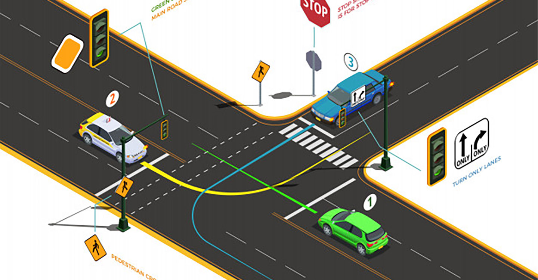The recent trends show that the most effective companies are using eLearning to stay on top. Other businesses follow in their footsteps but switching from instructor-led training is complicated and carries significant risks. In this article, we will make a case for moving to eLearning, present a step-by-step plan on how to do it, and warn you about the common mistakes
How Belitsoft Can Help
We are ready to bring our eLearning experience to assist you. Here’s what we can do:
- Consulting. Assessment of your current training program, selecting the best tools, designing gamification, and more.
- Course development. Creation of quality eLearning content in any form, from text and videos to learning games and simulations.
- Custom LMS development. We can provide you with a ready-made learning management system to host your new digital course or develop a new one from scratch.
What is Instructor-Led Training?
Instructor-led training (ILT) refers to all kinds of learning where knowledge is transferred from person to person: school classes, university lectures, tutoring, webinars, etc. This includes both group and one-on-one training.
In the recent decade, the use of ILT has been steadily declining, while all forms of purely digital learning grew. However, it still remains widespread: 94% of the companies use it in some form, while fully digital training is utilized by 77% of firms. This is due to a whole slew of factors:
- Some practical skills (e.g. first aid) are better taught by an actual person.
- Corporate inertia. People don’t switch from the models that are already working.
- Learners’ preference for communication with other people.
- Effectiveness. ILT still ranks pretty high in terms of knowledge retention
Why You Should Switch to eLearning
There is a reason why the most effective companies include eLearning methods in their learning and development (L&D) programs. A number of them, actually.
Benefits for Business
-
Low costs. There is a number of examples demonstrating higher return-on-investment (ROI) in eLearning compared to live ILT. A computer storage media company converted its live course for technicians into a digital format and saved about USD 1.5 million over the next three years, decreasing their costs by 47%.
A large consulting company developed an eLearning course that ended up costing USD 106 per user, instead of USD 706 with live training. Over five years they saved USD 4.5 million.
The fact of the matter is, eLearning is much cheaper than live training due to the lack of many expenses: teacher salaries and related costs (benefits, taxes, etc.), classrooms, and other factors.
- Scalability. eLearning is much easier to scale than ILT - just have the extra people access the same materials. Live training, on the other hand, requires extra classrooms and teachers, which makes it less cost-effective.
- New methods. eLearning is head and shoulders above traditional training when it comes to using the cutting-edge instructional design methods. Gamification, microlearning, on-demand training, and other new approaches have proven their effectiveness in both knowledge retention and motivation, bringing value to the companies that use them.
Benefits for the Learners
- Convenience. eLearning allows employees to study whenever and wherever they want, as long as there is a device with an internet connection. The top programs allow on-the-job training, which helps both solve pressing problems the learners might have and improve their skills at the same time.
- Effectiveness. As shown by a number of studies, eLearning leads to better knowledge retention. The exact numbers vary from one research paper to another, but the trend is definitely there. The only caveat here is that the improved effectiveness only holds true when the eLearning programs use the new teaching methods.
- Less training time. On average, an eLearning course is shorter than its live counterpart by 40-60%. This means less time spent training and more time with the learners’ hobbies, families, and friends.
Converting ILT to VILT
Switching training methods takes time, money, and effort. Here’s how you should go about it to make your investments count.
1. Prioritize
If you have several live courses that you need to quickly digitize, decide on what to move first.
Some options are:
- The course that brings the most money
- The course that will start soon
- The course that has the most learners
- Etc.
While having the instructor deliver their classes online doesn’t take too much work, they still need to familiarize themselves with the software that you decide to use and maybe prepare the extras (e-books, quizzes, etc.).
2. Compensate
Online training often feels more impersonal than its live counterpart. So some of the learners might rightfully request partial refunds or perks to offset that. You can anticipate this and offer something in advance for some extra goodwill.
There is also a category of learners that need the certificate first and foremost. These include people who are legally required to engage in continuing education (e.g. doctors) or people who need compliance training. They generally feel less antagonistic towards the move to digital, as long as they still get to their long-term goal.
3. Prepare the instructors
You should work with the people who deliver learning just as well as with your customers. For them, the move to digital can bring extra hassle (e.g. having to learn how to work with a new VILT tool or an LMS) but many benefits as well. Besides the professional advantages, there is a solid personal one: not having to travel to the classroom.
4. Restructure
Online training, even if delivered by a person, feels different than in-class one. On one hand, the learners are more comfortable at home. On the other, they have a lot more distractions: pets, kids, social media messages on the same screen as the webinar, etc.
This means that you might have to rethink the way that the people are taught. Perhaps you need to add more interactivity to keep them engaged. Or split the long lessons into smaller chunks.
5. Pace the transition
There would inevitably be certain unexpected issues that will set back your digitization attempts. This is why you would be better off transitioning to VILT in increments. Lessons learned by moving your first couple of courses would help speed up digitizing the other ones.
6. Choose the appropriate tools
If you only have one course, you would probably be fine with any popular webinar software. However, the more courses you manage, the better you will be served by an LMS. Who knows, maybe you will supplement VILT with completely electronic training, and then a learning management system becomes pretty much a must-have.
Best Practices
Here’s what you should include in your conversion program:
- Expert involvement. If you are training people to operate new coffee makers, for example, it would be best if an experienced barista is on board. They can give advice from personal experience and point out things that an outsider wouldn’t think about.
- Content transformation. Don’t just blindly copy and paste content, even if it is good. Sometimes it can be improved by converting it to a different medium (e.g. text into video or audio).
- Microlearning. Instead of having 10 hour-long lessons, have 40 ones that take 15 minutes each. Not only it will make training more convenient, but having more specific and condensed information on hand will improve learning outcomes.
Checklists
- I’ve determined what’s working in the live program.
- I’ve determined what doesn’t work in the live program.
- I’ve determined the improvements I can make.
- I’ve rechecked the expected learning outcomes to fit with the new approach.
- I’ve determined whether the new program will be blended or fully automated.
- I’ve reviewed the material and picked the most important parts.
Common Mistakes
These are the typical mistakes that companies make when switching from ILT:
- Mindless conversion. Digitizing the live training program without making any changes is undermining yourself at best and a waste of time and money at worst. Many benefits of eLearning are realized only when the full extent of digital capabilities is used.
- Not using the new approaches. Gamification, microlearning, story-based training, and other innovative teaching methods dramatically improve the efficiency of an eLearning program and are very cost-effective.
- Trying to convert everything at once. Like any new endeavor, switching from ILT to eLearning carries risks. So it is wise to convert gradually, improving on things as you learn more about what works for you. The MVP approach would be helpful in this regard.
FAQ
What is the business case for ILT conversion?The most common cases for this are increasing the effectiveness of an existing program, saving money on training, and updating the information along with empowering the course with innovations in instructional design.
What can be converted?Some forms of content can be converted more easily than others. For example, you can just upload PowerPoint slides to an authoring tool and turn them into a video. Other training, like practical first aid exercises, can’t be digitized at all, although digital tracking of live exercises is possible.
Should you condense or expand content?eLearning content tends to be more condensed than the one used in live training. However, the main thing you should do is restructure it to better fit the new delivery model. As we’ve mentioned before, microlearning approach works best.
Rate this article
Recommended posts
Portfolio

Our Clients' Feedback






















.jpg)
.png)
.jpg)













Belitsoft has been the driving force behind several of our software development projects within the last few years. This company demonstrates high professionalism in their work approach. They have continuously proved to be ready to go the extra mile. We are very happy with Belitsoft, and in a position to strongly recommend them for software development and support as a most reliable and fully transparent partner focused on long term business relationships.
Global Head of Commercial Development L&D at Technicolor